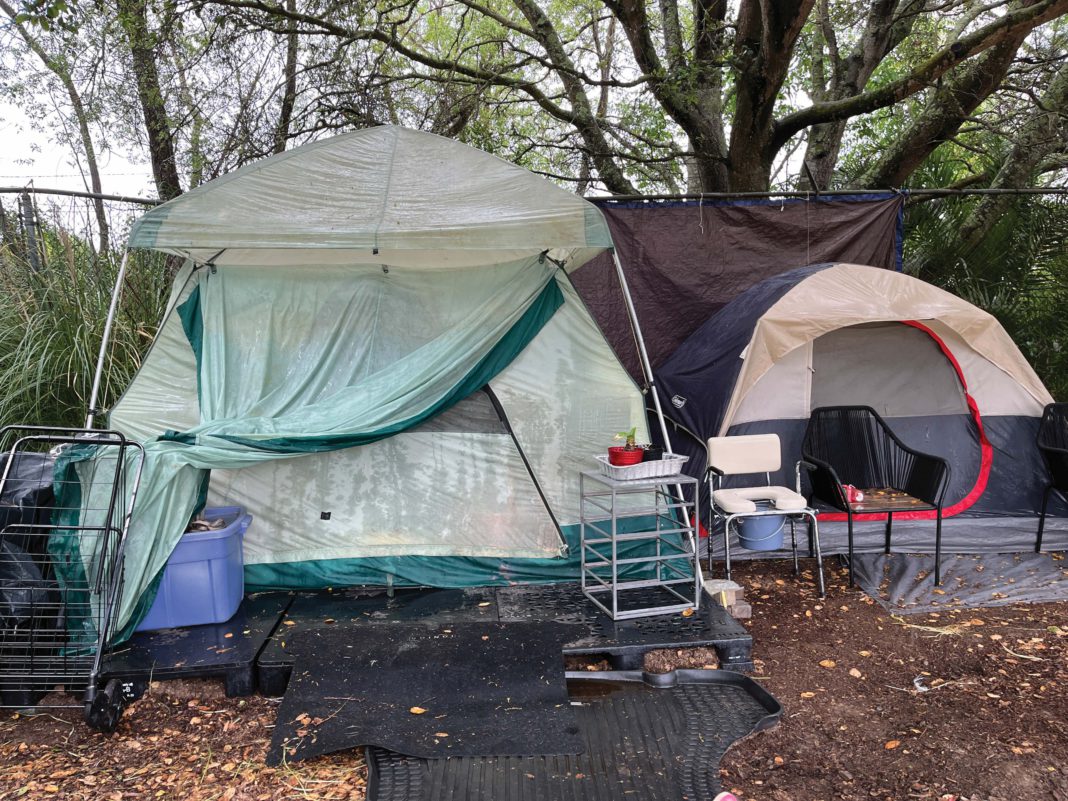Last week, Gov. Gavin Newsom continued his blustery rhetoric about clearing homeless encampments at the local level. Too bad the hoopla surrounding his new “model ordinance” is all hat and no cattle.
“It is time to take back the streets. It’s time to take back the sidewalks. It’s time to take these encampments and provide alternatives,” Newsom said at a news conference on May 12.
Exactly how does Newsom recommend cities and counties accomplish this lofty goal in a state that has a severe housing shortage and the largest homeless population—more than 187,000 people—in the nation? By “ending the excuses” and forcing homeless people living in encampments on public property to move every 72 hours.
Move where? Well, if there aren’t enough shelter beds, as is the case in Marin, folks can mosey on down the road a piece. To be precise, more than 200 feet from where a person camped the previous day, according to the ordinance that Newsom wants local governments to adopt.
The blueprint doesn’t just apply to those large, visible encampments seen under freeways and in parks around the Bay Area and the state. An encampment, as defined by the ordinance, includes a lone homeless person sleeping outside with a blanket.
Frankly, the plan gave me whiplash. The first basic principle begins with, “No person should face criminal punishment for sleeping outside when they have nowhere else to go.”
On the next page, the ordinance indicates otherwise.
“It is unlawful to camp on public property, including but not limited to using, placing or maintaining a tent, sleeping bag, blanket, or other materials for the purpose of sleeping, lying, or sheltering one or more persons for more than three consecutive days or nights in the same location,” the ordinance states.
How do local governments enforce laws? Citing, arresting, criminalizing.
Flip-flop. All in a single five-page document.
“You can’t have it both ways,” said attorney Andrea Henson, board chair for Where Do We Go, a Bay Area nonprofit serving the homeless. “Jurisdictions are criminalizing homelessness, and the previous executive order from the governor directed cities to clear homeless encampments.”
Last year, Newsom also demonstrated his support for criminalizing homeless people by submitting an amicus brief in the case of City of Grants Pass v. Johnson when it came before the U.S. Supreme Court. Indeed, the case turned out as Newsom wanted. The court ruled that regulating camping on public property does not constitute cruel and unusual punishment prohibited by the Eighth Amendment, which then paved the way for cities and states to criminalize homeless people for sleeping outside.
Yet, the governor’s model ordinance decries policies banning people from sleeping outside on public property without offering adequate indoor shelter as “inhumane.”
Newsom is either mighty confused or has decided to pander to both sides of the political aisle. Pundits have long predicted that the governor plans to run for president in 2028.
Most California voters believe that Newsom is devoting more of his attention to running for the White House than to helping the state solve its problems, according to a recent poll by UC Berkeley Institute of Governmental Studies.
While Newsom has certainly thrown money at local governments to deal with homelessness—now $27 billion since 2019—there has been little oversight. A state audit released in April 2024 found that the California Interagency Council on Homelessness had “not consistently tracked and evaluated the state’s efforts to end homelessness.”
In response, the governor expanded the responsibilities of the Housing Accountability Unit to monitor local governments as they address housing for the homeless.
California legislators also remain concerned about non-accountability, and have introduced several bills to ensure oversight. One example, Assembly Bill 750, currently under consideration, would require a city or county to annually inspect every homeless shelter in its jurisdiction and submit a report, even if a facility had no complaints. And this bill has teeth. Failing to comply or to correct a violation would result in withholding state funds.
But Henson, of Where Do We Go, isn’t convinced that enough is being done to protect homeless people.
“The unhoused need independent boards that will monitor how enforcement is conducted by law enforcement, how housing is provided by resource providers, how mental health services are successfully delivered and how subsidies are provided to keep individuals housed,” Henson said in an interview with the Pacific Sun.
“The governor talks about how money will flow, and resources will be provided, but homelessness is growing despite heavy spending. Criminalization and selective enforcement is growing without oversight. That [oversight] is what is needed now. Not unbridled discretion by law enforcement to sweep the unhoused and money thrown at a problem with no strict oversight,” Henson continued.
In 2024, Marin County received $18 million from the state’s Encampment Resolution Fund to assist people living in three different areas. The programs here are well-managed and paying off.
Almost $6 million was allocated to serve 65 homeless people living in San Rafael’s Mahon Creek Path area. Currently, 48 people reside in a city-sanctioned camp, with 31 of the individuals on a housing pathway. Fourteen former residents received housing.
A grant of more than $8.6 million has helped 60 people in Bolinas, mostly Latinx farm workers and their families, transition from deplorable living conditions to interim RV housing.
An RV encampment on Binford Road in unincorporated Novato received the remaining $3.7 million. It was the second award for the camp, which once had a high of 117 residents. Marin County has successfully administered the funds and helped place four dozen former residents in permanent housing. The encampment now has 54 residents, with 47 individuals moving through the housing process.
Perhaps Newsom should look to Marin County as a model, rather than sweeping homeless encampments and displacing people 200 feet down the road. Sure, a few of Marin’s cities and towns could do much better, but we do have some compassionate leaders making good decisions on behalf of homeless residents. Gary Naja-Riese, director of Marin County’s Homelessness & Coordinated Care department, and Marin County Supervisor Eric Lucan come to mind.
As for the governor’s model ordinance, Marin Homeless Union president Jason Sarris remains unimpressed.
“I think Newsom’s crumbling under the pressure and trying to sidle up to the right to run for president,” Sarris said. “It’s incredibly short-sighted. Most of California doesn’t have enough shelter beds or housing availability for all the people living outside—and it won’t, not anytime soon.”









I worked at both shelters in Marin for 2 years. My take which I’m sure will offend some, was that we have enough beds and provide a plethora of services. But what I saw was folks won’t show up for scheduled intake appointments to get in; they won’t give up their weapons; they insist on drinking and drugging inside the shelter; in short they want it both ways; total freedom, no rules or requirements and public to provide everything for them; food, housing, health care, free money.
Hi Bryan,
I’m not sure how long ago you worked at the local shelters, both operated by Homeward Bound, but there has been a shortage of shelter beds in Marin for many years. Consider this statement provided three weeks ago by Homeward Bound CEO Paul Fordham:
“Our shelters remain at capacity,” Fordham said. “Whenever we have openings, they are filled very quickly. We receive at least 25 requests for each bed that comes available, so we can never guarantee that anyone will get a bed.”
While I’m sure that there are homeless people who fit the description in your comment, it is unfair to paint all with these broad statements. Research bears out that most homeless people are not service resistant.
Best,
Nikki
Hi Bryan,
When the CEO of Homeward Bound says that there are at least 25 requests for each bed that becomes available and that they get filled very quickly, it seems very clear to me that there are many unhoused people who are willing to go into the shelter and abide by the rules. Also, a search online shows that the meaning of “at capacity” is: something is filled or occupied to its maximum limit. In other words, the shelters are full. And just to be clear, it has been reported by Nikki Silverstein in previous articles that there are 1,090 homeless in Marin (based on the 2024 HUD Point and Time Count) and only 163 beds available in the county. Less than 15% of the homeless population can even get into a shelter on any given night. So in reality, No there aren’t enough shelter beds in Marin.
It’s ironic that Newsome ignores Marin when it’s convenient, but looked a little crestfallen that no one here had a parade waiting him when he moved to Kentfield with his family recently.
You’d think he’d have noticed…
Tracie Palmer
Secretary, MC-LEAB